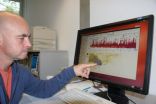(Press-News.org) This news release is available in German.
Historic stone buildings are tourist magnets. The Jordanian rock city of Petra, the medieval town of Rhodes in the Aegean Sea and the sandstone temples at Luxor, Egypt, for example, attract hundreds of thousands of visitors each year. These cultural assets all have one thing in common: they suffer from weathering caused by salts. These crystallise inside the porous building materials and generate enough force for the stone to break or crumble. The same problem also occurs in concrete buildings in this country.
Researchers at the Institute for Building Materials at ETH Zurich and at Princeton University have now conducted an experiment to test the effect of salts under controlled conditions. They are hoping the results will help conservators and restorers of cultural assets to predict the weathering process of buildings.
Salt can enter building materials in a variety of ways, explains Francesco Caruso, a post-doctoral researcher in the group of Robert Flatt, Professor of Building Materials. Cement, for example, a component of concrete, always contains gypsum (calcium sulfate) and alkali sulfates, both of which are salts. Building materials can also be infiltrated by salt from the environment, such as through mineralised ground water close to the surface, which permeates porous building materials through capillary force, or via the atmospheric pollutant sulfur dioxide, which reacts with the calcium carbonate in limestone to form gypsum.
Damage can also be caused by de-icing salt and seawater spray that accumulates on the surface of buildings. "If these salts are dissolved by rain, the saline liquid can enter the building material through pores and cracks," explains Caruso. The salts crystallise as the liquid dries out and evaporates, causing parts of the stonework to crumble away.
Temperature differences lead to salt accumulation
For their laboratory experiment, the ETH researchers used sodium sulfate, the most destructive salt known and which exists in two forms: anhydrous and hydrated. In several cycles, the researchers placed limestone cubes with a side length of two centimetres into a sodium sulfate salt bath, allowing the salt solution to permeate the pores of the limestone. They then dried the stones at high temperature before placing them in the salt bath again at a lower temperature for the next cycle. During the drying phases, the salt crystallised in the stone's pores in anhydrous form. In the salt bath phases, the salt solution permeated the pores again and the crystallised salt turned back into a liquid solution.
With this controlled cyclical process, the scientists managed to accumulate a large amount of salt within the stone and create a supersaturated salt solution with respect to the hydrated form. A supersaturated salt solution is a liquid in which, because of special circumstances, more salt is dissolved than would be possible under normal circumstances.
Important findings for restorers
The experiment showed that the greater the supersaturation, the greater the salt's destructive potential. Temperature also played a role: in cycles in which the temperature never fell below 25˚C, it took an average of four cycles before damage occurred. When the temperature dropped to 3˚C, one cycle was enough. "Although these wet and dry cycles play a part, supersaturation is the most important factor," explains chemist Caruso.
For a building, this means that if environmental conditions are such that a salt solution repeatedly infiltrates porous stone and the fluid can then evaporate again (e.g. due to strong sunlight or wind), the salt in the building material can become supersaturated. "In these cases, it doesn't take a lot of salt to inflict considerable damage," says ETH professor Flatt. However, higher amounts of salt are needed in more moderate environmental conditions.
With this controlled experiment, the researchers have been able to describe the phenomena of salt damage in detailed physico-chemical and mechanical terms for the first time. "We have shown that damage caused by salt can be predicted, at least under controlled conditions," says Flatt. He believes the experiments may help conservation scientists decide how much salt needs to be removed from a building to avoid damage or – if the salt cannot be removed – to predict when a building might be damaged.
Michelangelo's frescos and geothermal drilling
This damage caused by salt is not seen only on historic buildings. It is also a problem for wall paintings, such as Michelangelo's frescos inside the Sistine Chapel in the Vatican, says Caruso. These can be damaged by salt efflorescence in the stonework or the paint layers or in between.
The problem is also visible on a large scale in erosion processes and during geothermal drilling. "Salt damage forms entire rock landscapes," says Caruso. In 2007, geothermal drilling in the old town of Stauffen, Germany, raised the ground by up to 26 centimetres in places, causing cracks to appear in rows of houses. It was later discovered that due to the underground drilling, groundwater had entered a layer containing calcium sulfate in anhydrous form, which reacted with the water to form gypsum. The supersaturation of this gypsum generated enough pressure to lift the ground.
The researchers at ETH are now planning to use their findings in a project in Havana's old town, where salt is a major issue. The special render used in restoration work crumbles away from building façades after just a few years, and the aim of the research project is to discover the exact cause. The scientists involved in this research at ETH Zurich and Princeton University are also hoping to find ways to reduce salt damage, such as by changing the pores of building materials on a molecular scale.
INFORMATION:
Literature reference
Flatt RJ, Caruso F, Aguilar Sanchez AM, Scherer GW: Chemomechanics of salt damage in stone. Nature Communications, Online publication 11 September 2014, doi: 10.1038/ncomms5823 [http://dx.doi.org/10.1038/ncomms5823]
How salt causes buildings to crumble
2014-09-11
ELSE PRESS RELEASES FROM THIS DATE:
Ticks that vector Lyme disease move west into North Dakota
2014-09-11
According to the U.S. Centers for Disease Control, there are more than 300,000 cases of Lyme disease in the U.S. each year. Last year, most Lyme disease cases reported to the CDC were concentrated heavily in the Northeast and upper Midwest, with 96 percent of cases in 13 states. In fact, the disease gets its name from the northeastern town of Lyme, Connecticut, where it was first discovered.
However, a new article published in the Journal of Medical Entomology reports that the ticks that vector Lyme disease — Ixodes scapularis, also known as blacklegged ticks or deer ...
Increased access to nature trails could decrease youth obesity rates, MU study finds
2014-09-11
VIDEO:
Researchers at the University of Missouri and the University of Minnesota have found that local governments can help reduce youth obesity levels by increasing the amount and type of public...
Click here for more information.
COLUMBIA, Mo. – As youth obesity levels in America remain at record high levels, health professionals and policymakers continue to search for solutions to this national health issue. Now, researchers at the University of Missouri and the University ...
Study finds high protein diets lead to lower blood pressure
2014-09-11
(Boston)--Adults who consume a high-protein diet may be at a lower risk for developing high blood pressure (HBP). The study, published in the American Journal of Hypertension, by researchers from Boston University School of Medicine (BUSM), found participants consuming the highest amount of protein (an average of 100 g protein/day) had a 40 percent lower risk of having high blood pressure compared to the lowest intake level.
One of three U.S. adults has hypertension and 78.6 million are clinically obese, a risk factor for the development of hypertension. Because of the ...
New defense mechanism against viruses discovered
2014-09-11
This news release is available in German. When it comes to defence against viruses, the immune system has an arsenal of weapons at its disposal including killer cells, antibodies and messenger molecules, to name just a few. When a pathogen attacks the body, the immune system usually activates the appropriate mechanisms. However, some of the mechanisms do not have to be triggered; they are continuously active as a standing army. Researchers from ETH Zurich, in collaboration with scientists from the University of Bern, have now discovered a new form of this so-called ...
UM research reveals secrets of animal weapons
2014-09-11
MISSOULA – From antlers to horns, humans have long been fascinated by animals' ability to defend themselves with their natural-born weapons. But until now, no studies have directly tested whether those weapons perform better at the animals' own style of fighting than they would using the fighting style of another species. Researchers at the University of Montana recently discovered each species' weapons are structurally adapted to meet their own functional demands of fighting.
The groundbreaking research, conducted over the past year by UM doctoral student Erin McCullough ...
Excitonic dark states shed light on TMDC atomic layers
2014-09-11
A team of Berkeley Lab researchers believes it has uncovered the secret behind the unusual optoelectronic properties of single atomic layers of transition metal dichalcogenide (TMDC) materials, the two-dimensional semiconductors that hold great promise for nanoelectronic and photonic applications.
Using two-photon excitation spectroscopy, the researchers probed monolayers of tungsten disulfide, one of the most promising of 2D materials, and found evidence for the existence of excitonic dark states – energy states in which single photons can be neither absorbed nor emitted. ...
Cutting health-care costs 1 appendix at a time
2014-09-11
(SALT LAKE CITY)—Consumer price comparison is almost nonexistent in the U.S. health care system, but a new study shows that when given the choice between a less costly "open" operation or a pricier laparoscopy for their children's appendicitis, parents were almost twice as likely to choose the less expensive procedure – when they were aware of the cost difference.
The study, published in the September issue of Annals of Surgery online, shows that providing pricing information upfront can influence patient choice of surgical procedures and potentially lead to cost savings ...
Endometriosis a burden on women's lives
2014-09-11
Endometriosis often takes a long time to be diagnosed and affects all areas of a women's life, a study has found.
Research led by Monash University's Kate Young published in the Journal of Family Planning and Reproductive Health Care found that endometriosis affects women's sex lives, personal relationships, work life, and emotional wellbeing.
Endometriosis is a chronic, recurring disease that is experienced by approximately 10 per cent of women worldwide. Common symptoms include painful menstruation, heavy menstrual bleeding, painful sex and infertility.
Ms Young, ...
Perfect focus through thick layers may bring better vision to medicine
2014-09-11
WASHINGTON, Sept. 11, 2014—Zooming in on diseased tissue or scanning fragile biological samples are essential tools in medicine and biological research, but this often requires peering through layers of tissue and other materials that can blur and distort the image. Certain modern microscopes can compensate for this, but only for weak aberrations or by using invasive "guide stars," imaging aids that provide a stable reference point.
In a first-of-its-kind demonstration, published today in The Optical Society's (OSA) new high-impact journal Optica, a team of researchers ...
The ozone hole has stabilized -- some questions remain
2014-09-11
After the detection of the ozone-depleting properties of CFCs in the 1970s, data from satellite measurements in 1985 startled mankind. A huge hole had been discovered over the Antarctic in the ozone layer that protects the Earth from dangerous, carcinogenic UV rays. Already in 1987 politicians around the world reached agreement on the Montreal Protocol that bans ozone-depleting substances, in particular chlorofluorocarbons (CFCs). 197 states have now ratified this international treaty. A series of scientific expert reports has since accompanied the efforts to save the ozone ...



